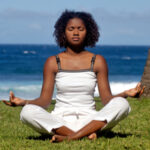Key Facts
- Deep breathing has many benefits.
- Deep breathing exercises can be used when you feel stressed or anxious.
- Deep breathing exercises are useful before medical tests and procedures.
 Deep breathing is a type of exercise that makes you aware of your breathing so when you inhale (take in air) through your nose, the breath is long and slow and the air completely fills your lungs. The second part of the exercise is to blow out all of the air from your lungs, nice and slowly. You should see your lower belly rise when you breathe in and lower when you breathe out.
Deep breathing is a type of exercise that makes you aware of your breathing so when you inhale (take in air) through your nose, the breath is long and slow and the air completely fills your lungs. The second part of the exercise is to blow out all of the air from your lungs, nice and slowly. You should see your lower belly rise when you breathe in and lower when you breathe out.
What affects breathing?
Stress, anxiety, anger, fear and other emotions can cause your breathing to become faster than normal. When you are happy and content your breathing is slower, and more regular.
How can deep breathing exercises help me?
Deep breathing can help you relax, decrease anxiety, improve coping skills and even help to lower your blood pressure.
When should I use deep breathing exercises?
Deep breathing exercises can be used when you feel stressed, anxious, or you’re in any situation where you need to slow down and feel in control. For example: if you’re anxious before a test at school, deep breathing is a great tool to use to help you relax and focus. Even if you feel stressed in the middle of a tough day, taking a few deep breaths will help you feel relaxed and calm.
Deep breathing can also be useful before any medical tests or procedures, such as when you have your blood drawn. Deep breathing gives you a feeling of peace and is an easy skill to learn and use whenever you feel anxious or tense.
Who can teach me about deep breathing exercises?
Many different types of health care providers (HCP) can talk to you about deep breathing exercises including nurses, health care providers, social workers, and psychologists. Deep breathing is often connected with yoga and meditation so teachers who are trained in these activities can also show you how to do it.
I don’t have a lot of free time, is deep breathing exercise something I can do on my own?
Yes! You can use deep breathing exercises anytime for as long or short as you want. Unlike other forms of exercise you don’t need any equipment, and it’s free!
How do I do deep breathing exercises?
Something simple to do is: Close your eyes for a few minutes and imagine yourself on a beach or another place you find relaxing. Then, take a deep breath through your nose and count to ten. Release the breath through your mouth until you have pushed all the air out. Then repeat the exercise.
Important things to remember when practicing deep breathing exercises:
- Find a quiet and comfortable place where you can sit or lie down where no one will bother you for a while.
- Sit or lie in a comfortable position with your back straight.
- Close your eyes and imagine yourself in a relaxing place.
- Take a couple of “cleansing breaths” (breathing in through your nose and out through your mouth) and find a comfortable position, either sitting or standing.
- Breathe in through your nose and out through your mouth using your abdominal muscles so your diaphragm can flex and contract.
- Inhale slowly. This should take about 10 seconds. (You can count in your head to 10) so that your lower abdomen rises and falls. Now, exhale slowly for another 10 seconds.
- Try to get into a routine and practice deep breathing for 5-10 minutes each day. Practicing helps you get into a routine so you can use deep breathing whenever you feel the need to relax or calm down.
Our health guides are developed through a systematic, rigorous process to ensure accuracy, reliability, and trustworthiness. Written and reviewed by experienced healthcare clinicians from Boston Children's Hospital, a Harvard Medical School teaching hospital and consistently ranked as a top hospital by Newsweek and U.S. News & World Report, these guides combine clinical expertise, specialized knowledge, and evidence-based medicine. We also incorporate research and best practices from authoritative sources such as the CDC, NIH, PubMed, top medical journals, and UpToDate.com. Clinical specialists and subject matter experts review and edit each guide, reinforcing our commitment to high-quality, factual, scientifically accurate health information for young people.
